Buff Wyandotte: Breed Profile
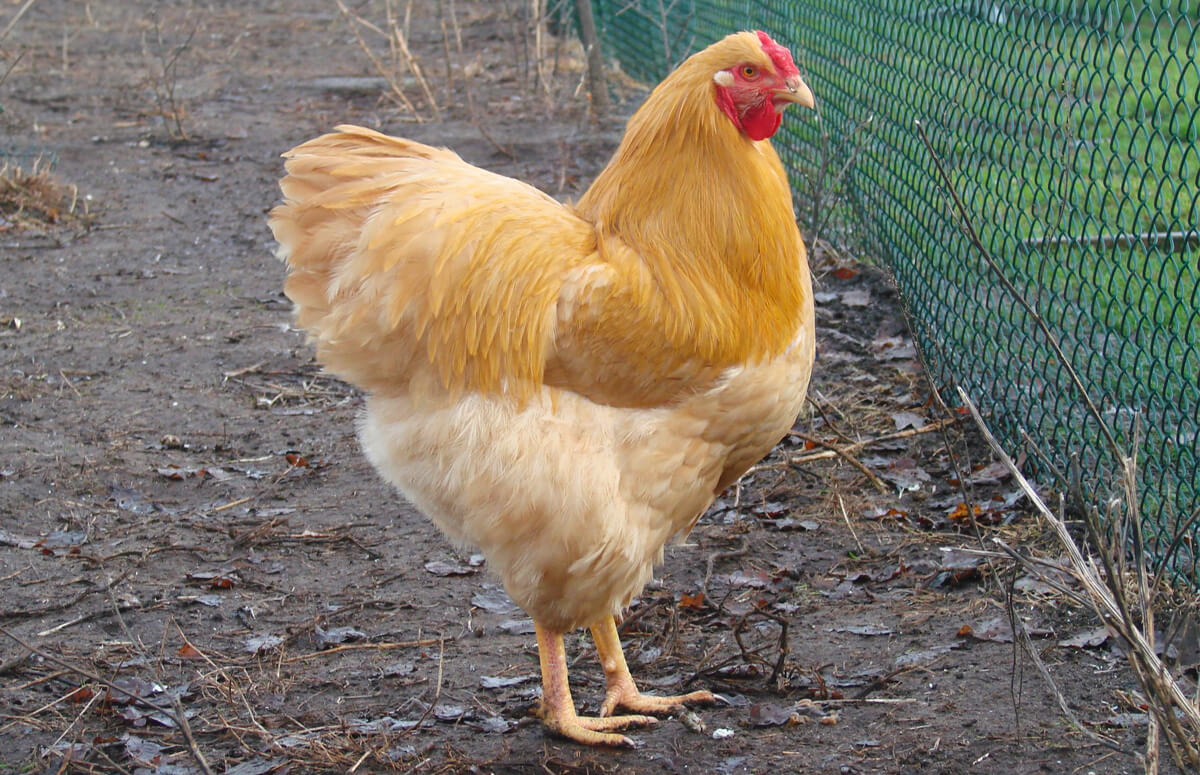
Characteristics | Eggs | Pros & Cons | Rooster vs Hen | Climate | Buff Color | Climate | History | Genetics | Personality
The Buff Wyandotte is a yellow-brown variety of the Wyandotte. Although Buff is a standard color, it’s less common for Wyandottes, especially compared to Orpingtons.
Characteristic
The Buff Wyandotte’s signature look comes from its deep yellow to golden-brown feathers that echo a wheat field in the sun. Both male and female Wyandottes have this golden-brown look, but the males tend to be a bit brighter.
Buff is one of the nine standard colors in the US, as recognized by the American Poultry Association. In Europe, thirty colors are listed, including Buff, Buff Columbian and Buff Laced.
| Eggs | 200 eggs/year |
| Egg Color | Brown |
| Egg Size | Large |
| Weight | 6.5 – 8 lbs |
| Hardiness | Cold |
| Temperament | Friendly but assertive |
| Beginner-friendly | Yes |
| Color | Buff |
Wyandotte chickens have round and robust bodies, broad chests, and a medium-sized rose comb. The legs are bright yellow, and their beak is dark golden to yellow.
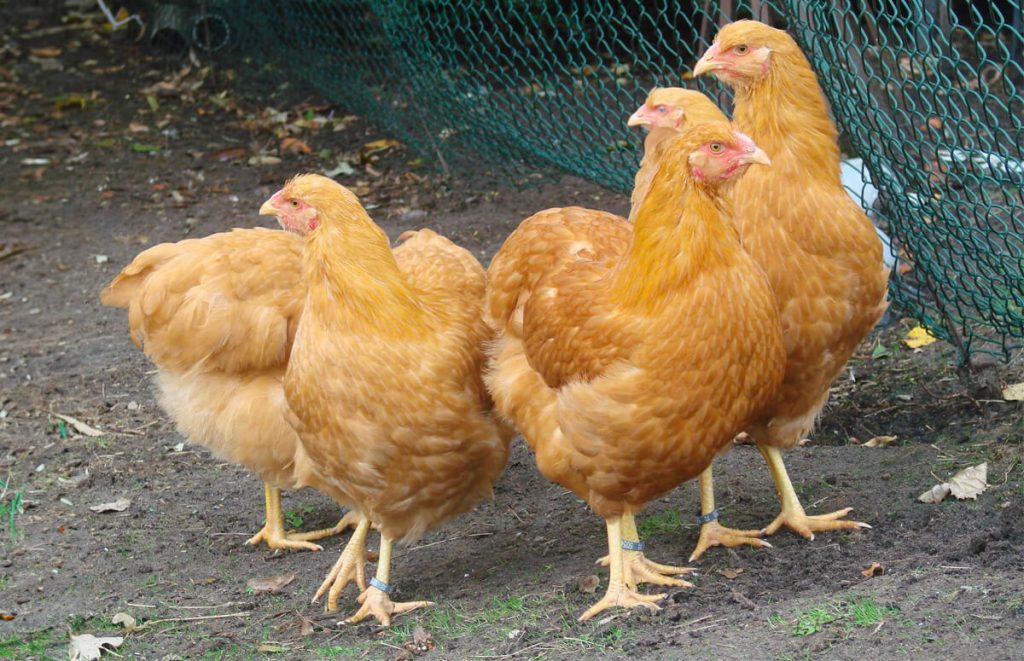
The weight of Wyandottes can vary, but on average, roosters typically weigh around 7 to 8 pounds (3.2 to 3.6 kilograms), while hens tend to be slightly lighter, ranging from 6 to 7 pounds (2.7 to 3.2 kilograms).
Wyandottes are a dual-purpose breed, used for meat and egg production. However, the Buff Wyandottes are usually kept for eggs, as backyard chickens, or as showbirds.
Buff Wyandotte Hen vs Rooster
Buff Wyandotte hens and roosters share some similarities, especially in the color of their plumage. Distinguishing them can be challenging for the untrained eye.
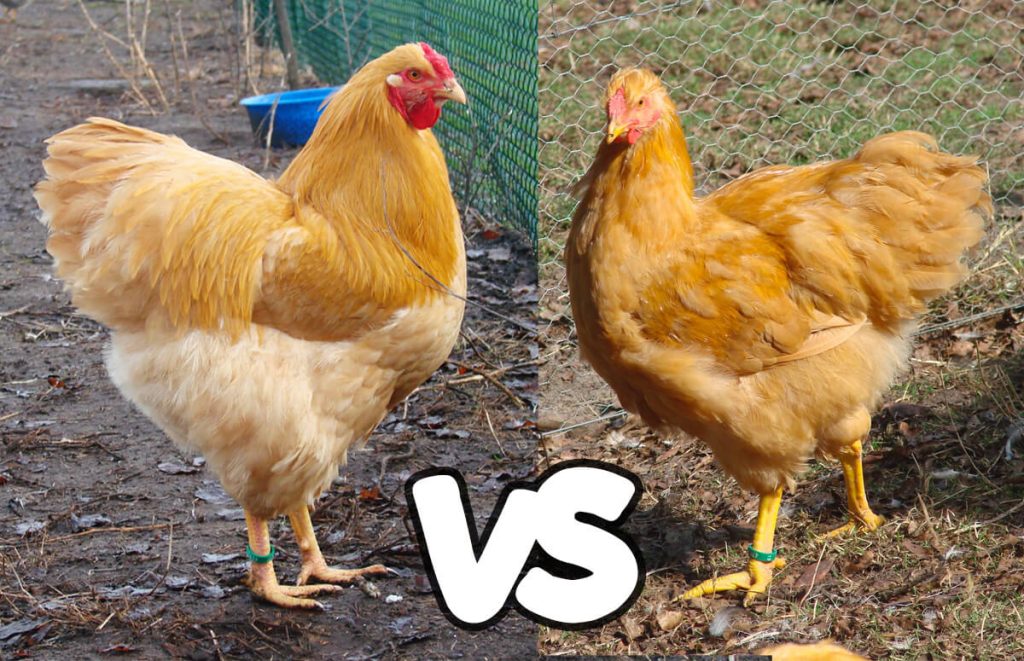
The primary difference between them lies in their feathering. Looking closely at the photo above, you can see that the rooster on the left has long saddle feathers, whereas the hen on the right has round feathers on the back and tail. The rooster also has sickle feathers on the neck.
Here’s a closer look at the differences between Black Wyandotte hens and roosters:
| Feature | Buff Rooster | Buff Hen |
|---|---|---|
| Weight | 8 lbs | 6.5 lbs |
| Back | Pointed saddle feathers | Rounded feathers |
| Plumage | Buff, bit brighter | Buff, a bit darker |
| Tail Feathers | Long sickles, pointed | Shorter, rounded on the edges |
| Comb, Wattles | Big, red | Small, pink |
| Body | Large and broad with long legs | Smaller, shorter legs |
Both Buff Wyandotte hens and roosters share the characteristic golden-brown feathering, making them look alike in color. However, keen observers may notice that the males can be slightly lighter in coloration. This difference can be subtle but becomes more noticeable as the birds mature.
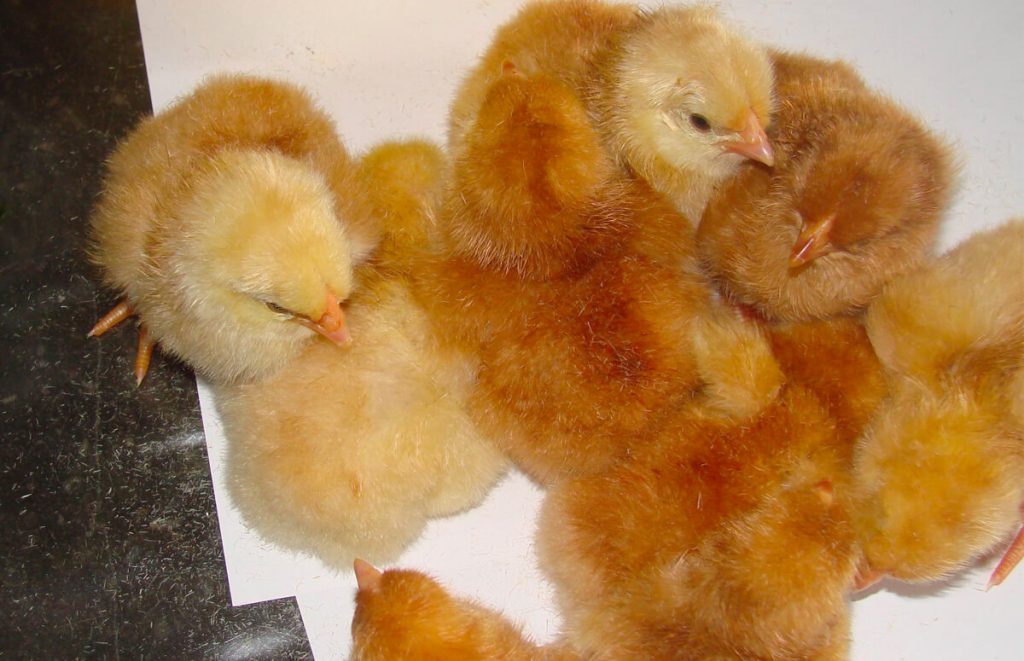
Buff Wyandotte chicks have a yellowish down with some red pigments. It’s impossible to differentiate between male and female hatchlings after hatching based on the down.
When they grow up, cockerels develop long, curved, and prominent tail feathers (sickles). These sickle feathers are absent in hens. Next to this feathering, roosters are, in general, bigger than hens.
Eggs
Buff Wyandottes are not only beautiful birds with golden plumage, but they also contribute delicious eggs to your kitchen. Their eggs are large in size and brown-colored.
Although not the best egg-laying breed, Buff Wyandottes are reliable layers. On average, they produce around 200 eggs yearly; that’s around four eggs per week. While this might not be the highest production rate among chicken breeds, it’s still a respectable number.
According to breeders, the eggs of the Wyandotte tend to vary slightly in color, but within the same Buff variety, the chickens usually lay the same shade of brown.
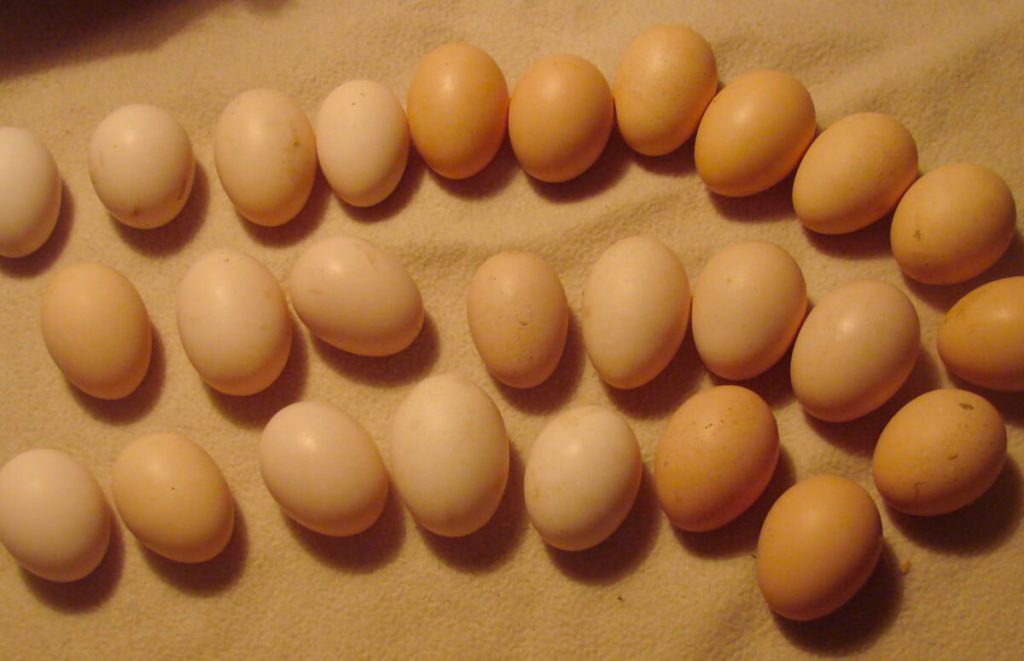
Some Buff Wyandottes exhibit broody behavior, which means the hens want to sit on their eggs to hatch chicks. This can benefit you if you’re interested in expanding your flock naturally, but it may also mean a temporary stop in egg production during broody periods.
Pros & Cons
Many chicken keepers love Wyandottes. Let’s explore the primary reasons for and against going for a Wyandotte chicken.
First, Wyandotte chickens are tolerant of cold weather. Their small rose combs and fluffy bodies allow them to be self-sufficient and withstand freezing temperatures. Furthermore, their striking buff feathers add charm to any flock, especially if you have an entire flock filled with Buff Wyandottes.
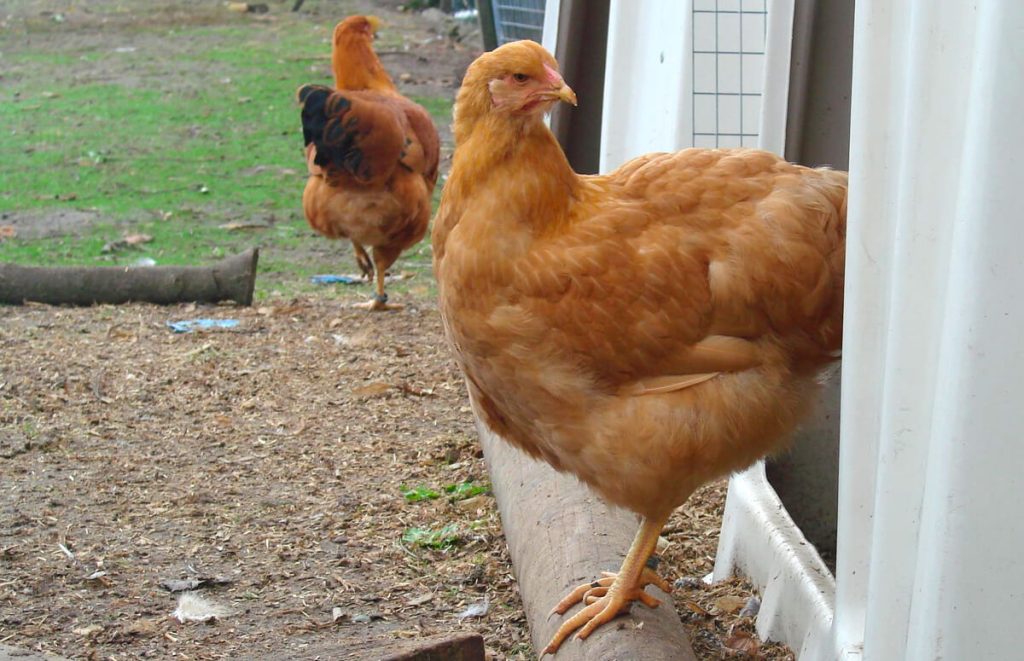
Their dual-purpose capabilities, meaning they excel in egg production and meat quality, make them an excellent choice for those seeking a self-sustainable life.
| Pros – Reasons to choose for Buff Wyandottes | Cons – Reasons to go for another breed |
|---|---|
| Cold-hardy Excellent foragers Dual purpose breed Beautiful buff color Don’t need much extra care Friendly towards people | Need more space Dominant towards smaller breeds Don’t do well in warm climates Some breeds lay more eggs They are no lap chickens Tend to go broody |
However, they need more space than most other breeds. And despite their cold-hardy nature, they do not fare well in warmer climates. Buff Wyandottes can also be dominant if you keep a mixed flock. It’s best not to keep them together with submissive or small breeds like Silkies or Faverolles.
Climate
Wyandottes have especially been bred since 1870 to stand cold American winters. Their small rose comb and fluffy body help them stand the cold and prevent frostbite.
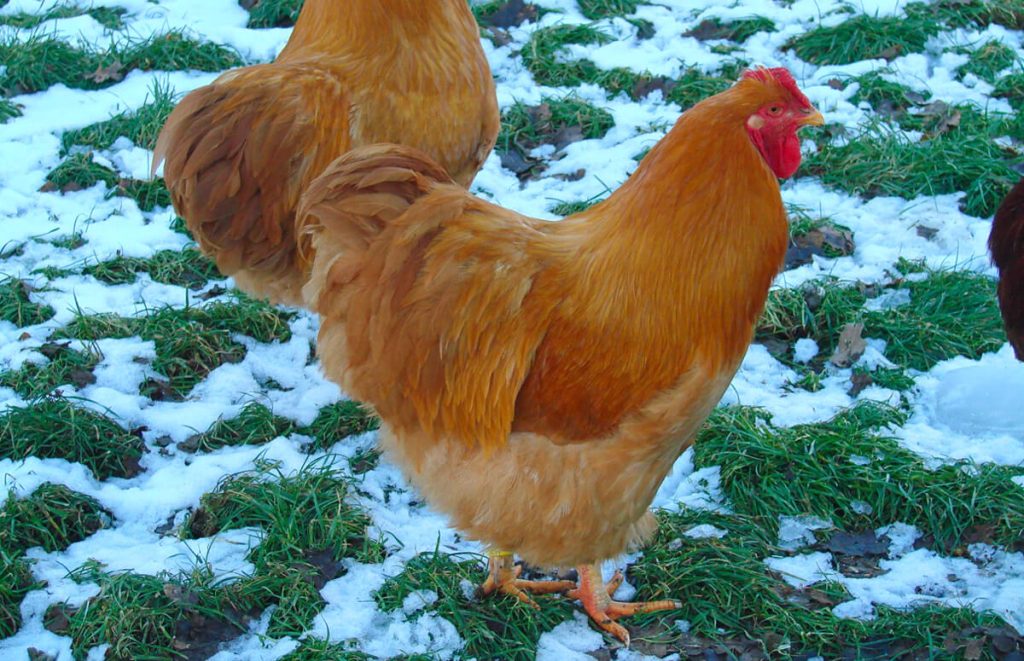
You can see in the photo that the Buff Wyandottes are untroubled by the chilly snow. However, they are no penguins either; their combs and wattles can still suffer from frostbite.
The other side of the medal is that Buff Wyandottes don’t like tropical temperatures. Keep them cool if you’re dealing with a heat wave.
Wyandottes are not the best breed to be kept in a Mediterranean or southern climate because of their body structure and comb size. They’ll quickly overheat and suffer heat stress.
The Buff Wyandotte Variety
The world of chicken colors and patterns can be complex. While The Standard of the American Poultry Association recognizes nine official varieties of the Wyandotte chicken, the Europeans list thirty colors.
Wyandotte chickens generally come in three classes:
- Laced Wyandottes: silver laced, gold laced, blue laced, …
- Marked Wyandottes: black-white Columbia, Partridge, Silver Penciled, …
- Single-colored Wyandottes: white, blue, black, buff, …
The most popular Wyandotte varieties are the marked and laced ones. Their beauty lies in the striking patterns covering their entire bodies.
The single-colored Wyandottes, like the Black, White, and Buff Wyandotte, are less popular among breeders and chicken enthusiasts.
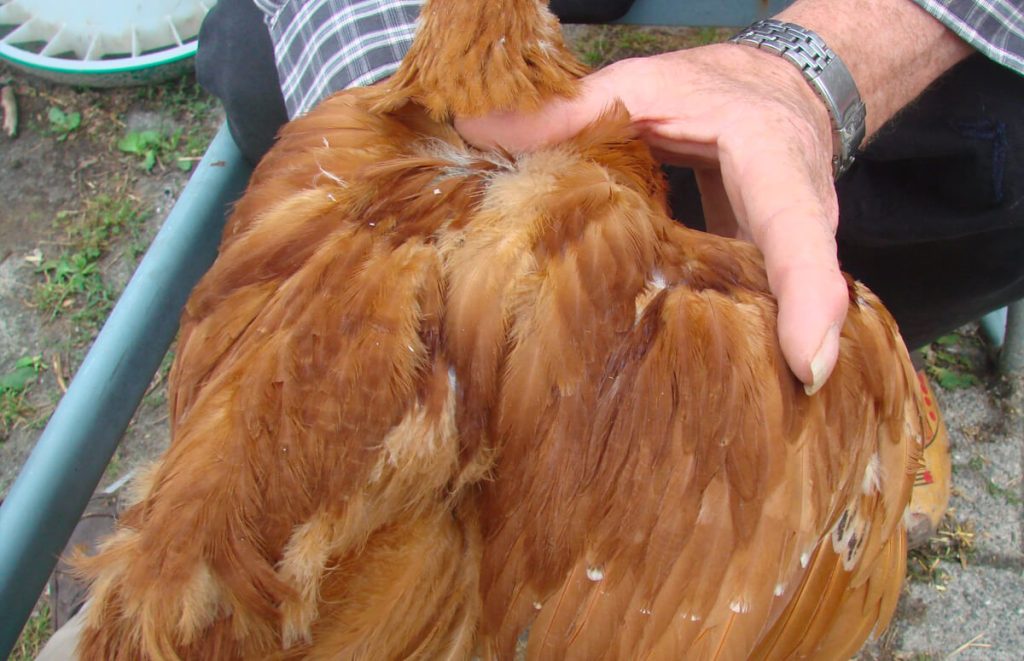
The yellow-brown color of the Buff Wyandottes is the ground color of the chicken, without any patterns or black pigmentation. It can be challenging for breeders to keep all the whites and blacks out of the feathers, as shown in the picture above.
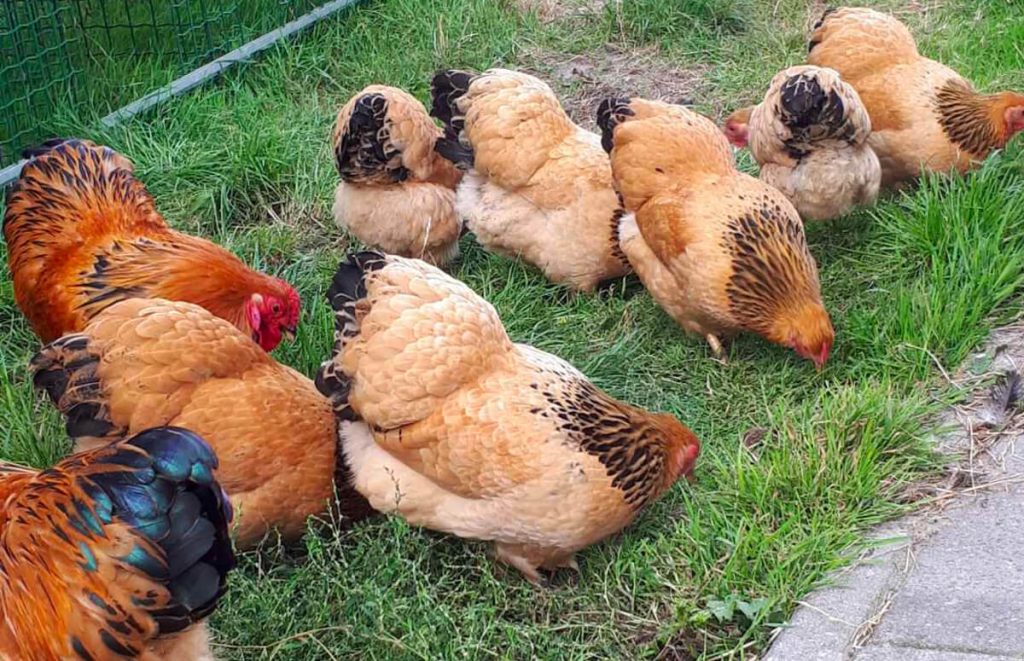
A more common variety of the Buff Wyandotte is the Buff Columbian. In the US it’s only recognized in the Bantam version, but in Europe it’s more common. These birds have the Columbian pattern in their plumage, with black in the hackles and a black tail.
Other Buff Wyandotte Color Varieties
There is also the Buff Laced Wyandotte, which has the same buff ground color but white lacing on the feathers. This variety looks much more like the Blue Laced Red Wyandotte, but with a yellow ground color:
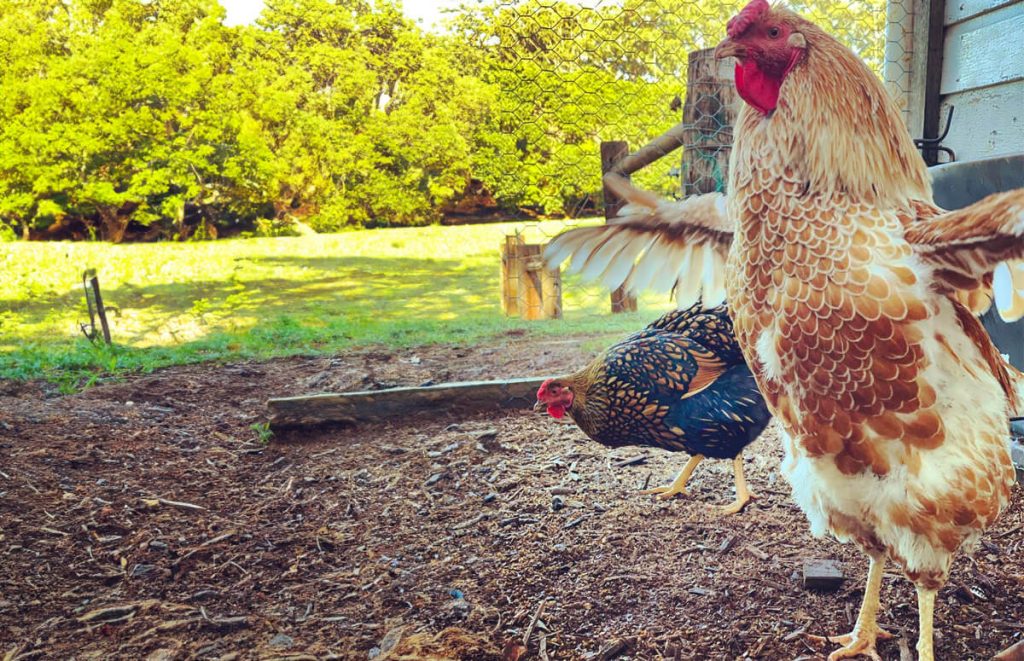
The yellowish-buff ground color can also show up in other non-official varieties of the Wyandottes that do have patterns and lacing. These birds are sometimes seen on shows and can look fantastic. A first example is the rare Buff Partridge Wyandotte that has black penciling:
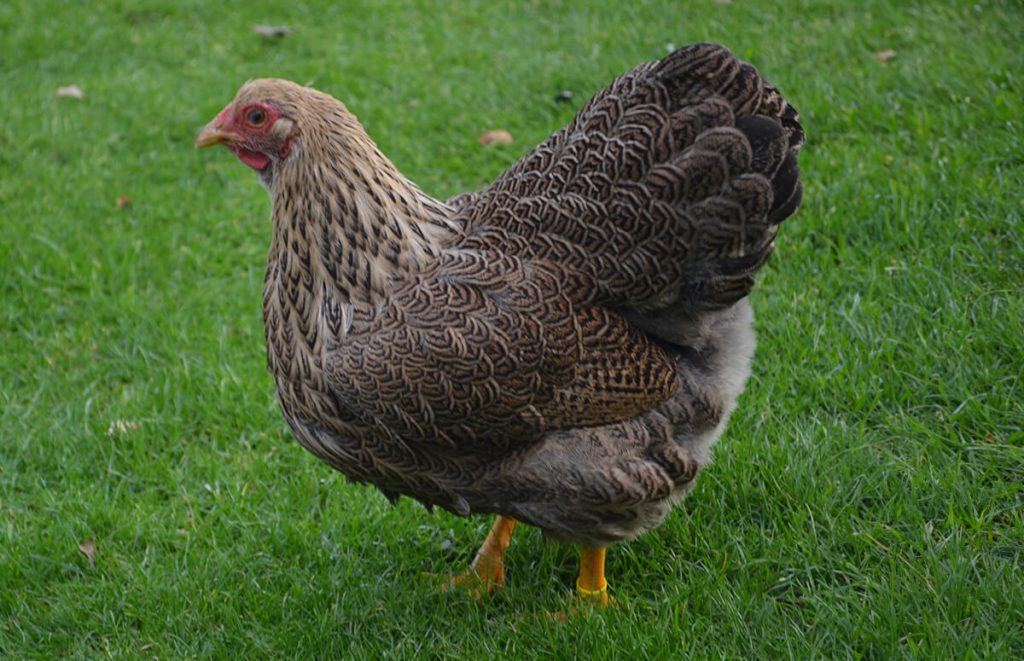
Another example is a mix of buff and blue in the same bird. Just look at the buff color in the hackles on the neck of this very rare stunning Penciled Blue/Buff Partridge Wyandotte:
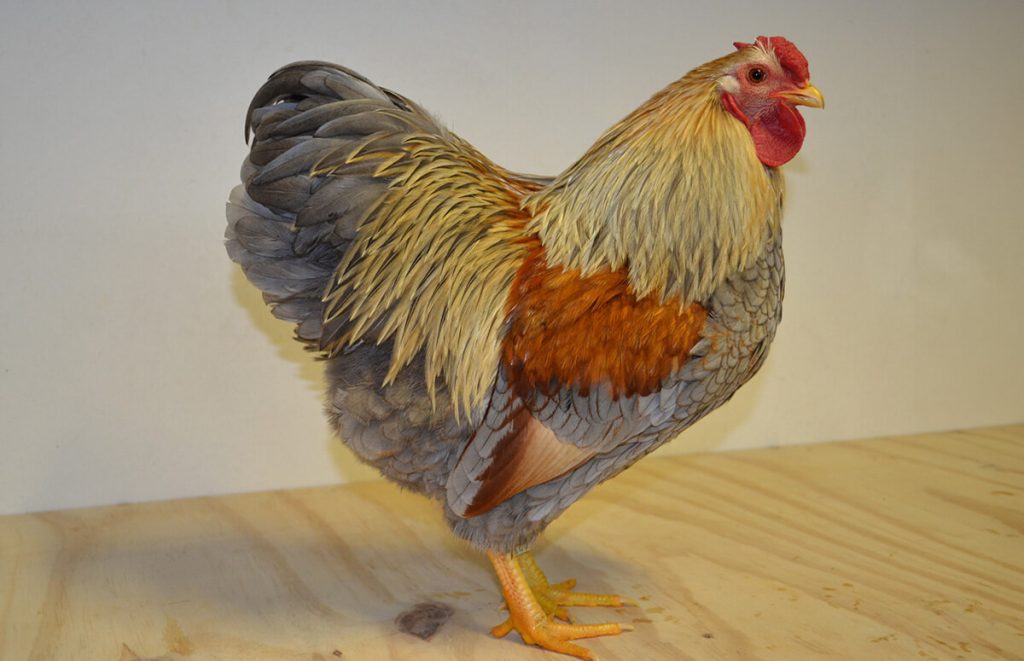
The title for the most popular buff-colored breed goes to the Buff Orpington. This variety of the Orpington chicken has conquered the hearts of chicken keepers worldwide. The Orpington’s gentle disposition and fluffy appearance have contributed to its popularity.
History of the Buff Wyandotte
The Wyandotte chicken was created in the United States during the 1870s by four breeders: H. M. Doubleday, John Ray, L. Whittaker, and Fred Houdlette. The Silver Laced Wyandotte was the first official color variation, gaining recognition in the American Standard of Perfection in 1883.
Over time, various color varieties of Wyandottes were developed, including the Golden Laced, White, and Partridge, among others. Each variety shows unique colors and patterns.
Several dedicated US-based breeders played a significant role in shaping the Buff Wyandotte into the breed we know today. Various breeding strains were created, with each breeder contributing expertise to refine the breed’s characteristics.
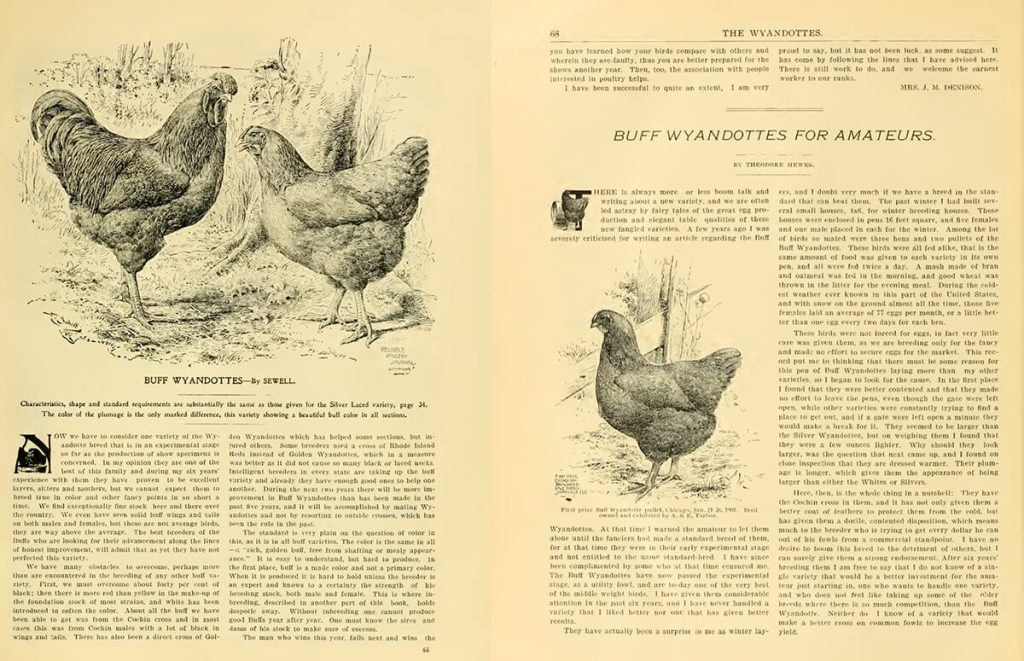
Breeders experimented with various combinations to achieve the desired characteristics, and the results were often achieved by crossing Rhode Island Reds with Silver Laced Wyandottes, Golden Laced Wyandottes with White Wyandottes, and Golden Laced Wyandottes with Buff Cochins.
Among the many breeders who contributed to the Buff Wyandotte’s success, George Brackenbury emerged as one of the most accomplished. His dedication and expertise in breeding Buff Wyandottes played a key role in shaping the breed into the magnificent birds they are today.
In 1893, the Buff Wyandotte received official recognition when admitted to the American Standard of Perfection.
Buff Wyandotte Genetics
The buff color of the Wyandottes is the actual ground color. The feathers don’t have patterns, and the black pigments are suppressed. That said, buff is a pretty mysterious color in general.
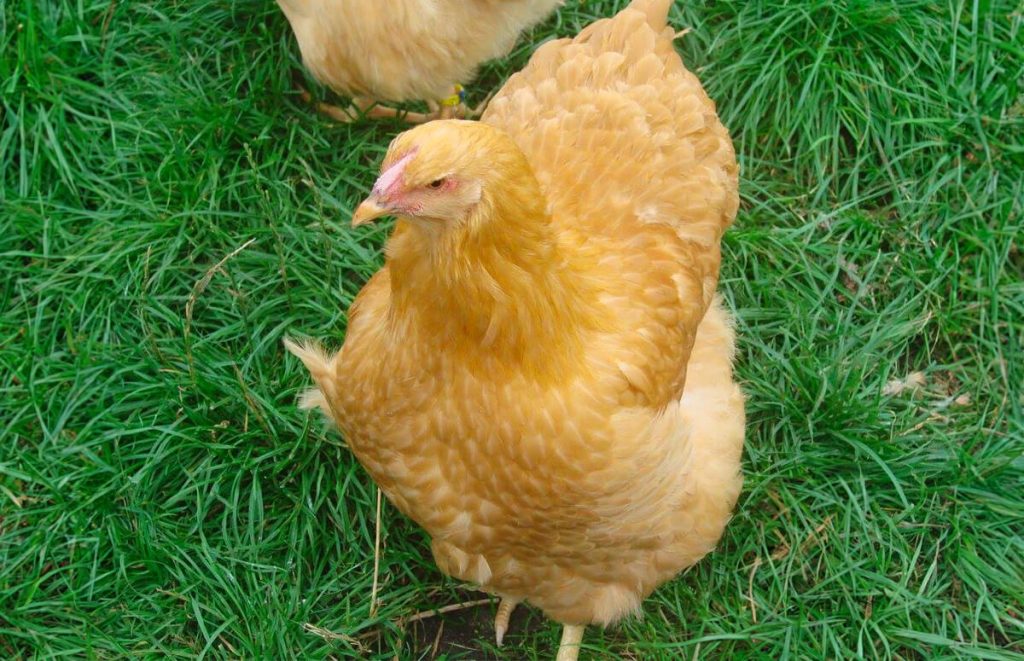
There is no single buff gene, and the color is the result of several other genes:
- Wheaten (Ewh): gives the birds a wheaten-colored plumage, with little to no black on the neck and back
- Columbian (Co): the Columbian pattern gene, although the typical Columbian pattern is very subtle to non-existent
- Dark brown (Db): reduces black pigments and enhances red pigments in parts of the plumage
- Mahogany (Mh): enhances the red pigments
- Red diluter (Di): dilutes the red pigments and changes the gold color to yellow/lemon
The combination of all these genes results in a beautiful uniform buff color. Ideally, all feathers are entirely brown up until the skin, showing no signs of black pigments. Here is what the consistent color of a Buff Wyandotte looks like in a spread wing:
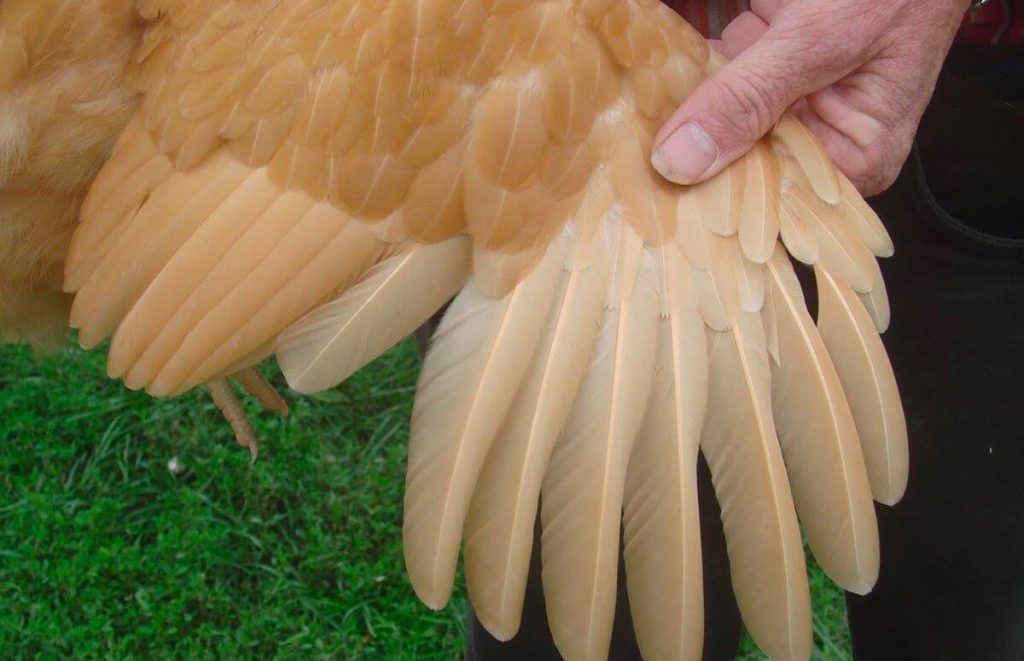
It’s also essential that the chickens don’t have the Pattern gene (Pg) or the Melanotic gene (Ml). This would cause the feathers to be striped.
Personality
Like other members of the Wyandotte breed, Buff Wyandottes are known for their friendly and pleasant personalities. Many chicken keepers favor them for their lovely temperament and adaptability.
They are often described as docile and approachable, making them a good choice for families and beginning chicken keepers.
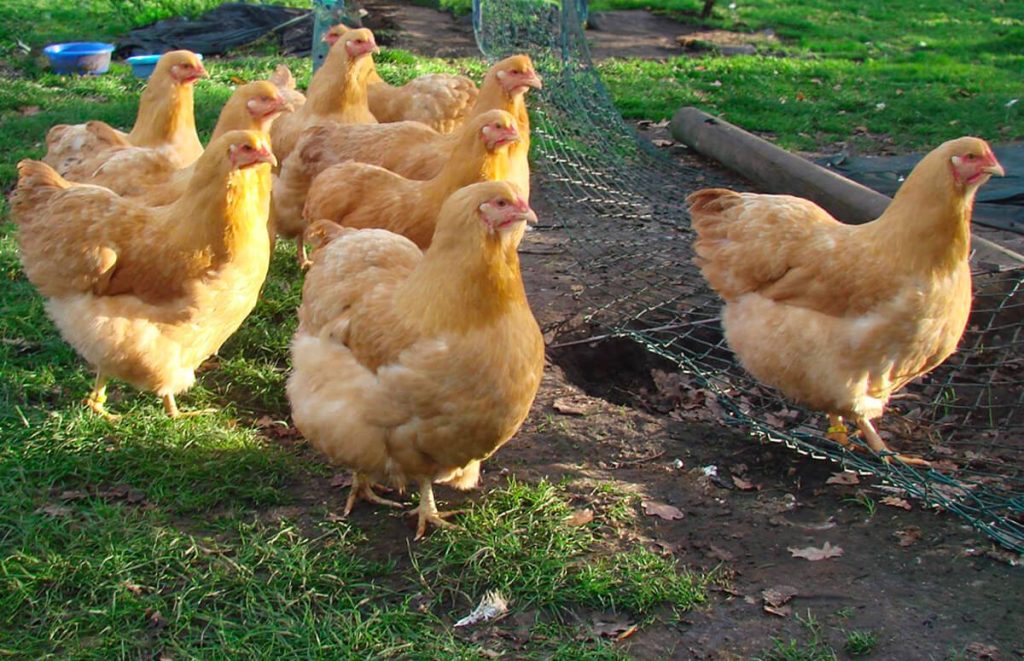
Though they can be dominant, Buff Wyandottes tend to be relatively calm and non-aggressive when interacting with other flock members. They can establish a pecking order but do so without excessive aggression.
Due to their assertive nature and slightly heavier build, Wyandottes are mostly positioned high in the pecking order.
Related Articles
Here are some of the articles we mentioned:
- Wyandotte Chickens: an overview of the Wyandotte chicken breed and the color varieties
- Silver Laced Wyandotte: a breed profile of the Silver Wyandotte variety
- Silver Penciled Wyandotte: a breed profile of the Silver Penciled Wyandotte variety
- Golden Laced Wyandotte: a breed profile of the Golden Laced Wyandotte variety
- Blue Wyandotte: a complete guide of the Blue Wyandotte chicken and blue varieties
- Buff Wyandotte: a complete guide of the Buff Wyandotte chicken and buff varieties
- Blue Laced Red Wyandotte: a comprehensive guide on this interesting variety
- Splash Laced Red Wyandotte: a guide on the Splash Laced Red variety
- White Wyandotte: a breed profile of the White Wyandotte
- Brahma Chickens: large chicken breed originally used to create the Wyandotte
- Hamburg Chickens: chicken breed used to create the Wyandotte
- Chicken Feather Guide: to understand the difference between all types of feathers
- Chicken Breeding & Genetics: an overview for chicken breeding and genetics for beginners
If you are considering to get Buff Wyandottes, here are some extra resources:
- Chicken Coop Size Calculator: to calculate the size of your coop
- Chicken Raising Guide: general chicken raising guide
Special thanks for photos and contributions go to Cactus Hill Poultry breeders and the experts at the Dutch Wyandotte Club, specializing in breeding Wyandottes.






















